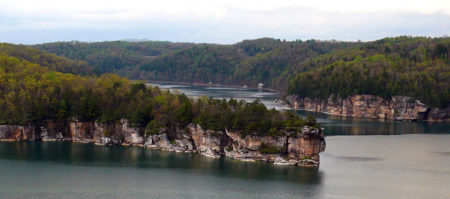Each spring in Appalachia, the rivers run high and fast! But the Gauley River in southern West Virginia won’t reach its high season until fall. In September, when excess water is released through Summersville Dam, thousands of whitewater enthusiasts from all over the world flock to the Gauley to experience what is considered by many to be one of the most thrilling whitewater opportunities in the world.
The Gauley River National Recreation Area established in 1988, protects 25 miles of the Gauley River and six miles of the Meadow River. Dropping more than 668 feet through rugged, remote terrain, this part of the river features more than 100 rapids with steep gradients, technical runs, an incredible volume of water, and huge waves. Like nearby New River Gorge National River and Bluestone National Scenic River, the Gauley’s deep gorge supports abundant and varied life. You’ll find forests of oak, beech, yellow poplar, hemlock, and dogwood. Rare and threatened species such as the Allegheny woodrat, cerulean warbler, eastern hellbender, and finescale saddled darter make their home on the Gauley River. Rare plants include Virginia spiraea, Appalachian blue violet, and balsam squaw-weed.
NPS Photo
If you are interested in “doing the Gauley,” a variety of commercial rafting companies can provide you with the experience during Gauley season, which begins the first weekend after Labor Day and continues Fridays through Mondays for six weekends. The Upper Gauley offers tremendous class III to V+ drops in steep, turbulent chutes such as Pillow Rock, Iron Ring, and Sweet’s Falls, and rocky routes that demand constant maneuvering, such as Lost Paddle and Shipwreck. The Lower Gauley is a 12-mile stretch, rated class III to V, that feels like a watery roller coaster. An insider tip…the river has much less visitation on Fridays and Mondays, providing a more wilderness experience. If you are interested in running the Gauley during the summer, commercial trips may be available depending on water levels.
Although whitewater provides the main draw for visitors to the Gauley River, rock climbing is a fast-growing sport in the area. There is also good trout and muskellunge fishing at the Gauley Tailwaters below Summersville Dam and near the confluence with the New River; you can fish for walleyes, muskies, and smallmouth bass.
Nearby Attractions:
Nearby attractions include Summersville Lake, run by the Army Corps of Engineers. The lake has superb water quality and sheer sandstone cliffs making it a unique place to visit. With 28,000 acres of water and 60 miles of shoreline, it is West Virginia’s largest lake. Boating, water-skiing, swimming, fishing, scuba diving, picnicking, camping, hunting, biking, and rock climbing are favorite activities.
Neighboring Carnifex Ferry Battlefield State Park has a museum, picnic shelters, hiking trails with stands of old growth forest, and overlooks of the Gauley River. Every other September, the important Union victory of Carnifex Ferry is reenacted. This defeat forced Confederate troops to withdraw from a drive to regain the Kanawha Valley, helping secure West Virginia in Union hands for the remainder of the war.
Camping:
The National Park Service offers primitive camping at Gauley Tailwaters campground located just below Summersville Dam. From Route 19 at Mt. Nebo, take Route 129 west across the dam, then turn left at the river access sign. Bear right through the parking lot to the campsites. There are 18 drive-in sites for tents and RVs.
Camping is allowed throughout the park on federally-owned lands unless otherwise posted. The National Park Service does not own most of the land within the boundaries of the Gauley River National Recreation Area. Be aware of private property and respect the rights of land owners. Unless developed sites are offered, campsites must be at least 100 feet away from any river access area, developed trailhead area, top edge or bottom of any cliff, park structure or historic ruin. The maximum stay is 14 days at the same camping area. There is no camping fee.
Open fires are allowed where campfire receptacles are provided and must be contained in these designated containers. Campfires are prohibited within 100 feet of any river access area, developed trailhead area, top edge or bottom of any cliff, park structure or historic ruin. Use only dead and down wood. Be sure your fire is out and cold before leaving. Do not burn tires or drive nails into trees. The use of chain saws is prohibited.
Camping at Summersville Lake is restricted to developed camping areas only – there is not random camping. Battle Run Campground is a class A Corps operated campground which has day use facilities, a boat launching ramp, access to fishing, showers, trailer waste disposal facilities, playground, universally accessible restrooms, parking, swimming and picnic areas. Battle Run Campground is now part of the National Recreation Reservation System. Reservations can be made by dialing 1-877-444-NRRS or on the web at ReserveUSA.com. For more information during recreation season call the campground at (304) 872-3459.
